
Hydroponic Systems
What are Hydroponic Systems?
Hydroponic system is the technique of growing plants without any soil, but only with water and mineral nutrients. The roots of the plants support the plants with water and nutrients that the plants need to grow. The roots can be only inside mineral nutrients or in an inactive media, such as gravel, perlite, mineral, wool, or expanded clay.
The soil is not an important factor in the growth processes of the plants; it’s working only as a storage place for the mineral nutrients; and the roots absorb the needs of the plant from (water and mineral nutrients) it. If you put the required mineral nutrient in artificially, it will be a suitable enough condition for any plant to grow.
Hydroponic Systems Advantages
- There is no need for soil in hydroponic Systems
- The water can be reused for a long time and this saves water resources, compared with the traditional cultivating methods
- The hydroponic systems are environment friendly. No nutritional pollution can occur compared with soil cultivations; because the system is controlled, resulting in no harmful pesticide damage
- High productivity compared with normal planting methods
- Stable system, very easy for anyone to establish it at his/her own home
- Easier to get rid of diseases and pests than normal soil; because as we have said before, it is a highly controlled system
- It is very easy to harvest
We can say that nowadays hydroponic systems are a trustworthy branch of agronomy. The culture of hydroponics is developing at an enormous rate, and in many countries it has big success. Finally, we can say that hydroponics is one of the highest agriculture producing methods, and is advised for places where traditional gardening is not possible.
Hydroponic Systems Disadvantages
To feed its plants, the hydroponic system needs all the time expensive nutrients and also on a regular basis creates waste water by flushing the system. As we already discussed, aquaponics system, is the perfect solution for this issue.
Hydroponic Systems Types
WICK SYSTEM
Hydroponic wick system is the simplest type of hydroponic systems. This is a static system, because there are no moving parts inside it.
Wick System Stages
- We put the nutrient solution into the tank
- Air pump is bubbling air inside the tank to supply the nutrient solution with oxygen
- Using wick, the nutrient solution is moving from the tank up to the grow-bed, which is full of growing media such as: gravel, vermiculite, perlite, expanded clay pebbles or any other ways that can be used as media
- The plants root inside the growing media, absorb the water and the nutrients they need to grow
Wick System - When to Use?
Wick hydroponic system is the answer for your needs when you want a simple system with small and short term plants.
Wick System Negatives
The biggest downfall of the wick system is that the wick(s) transfer rate is slow, and can’t supply big plants or long term ones which need a lot of water and nutrients.
WATER CULTURE
The water culture hydroponic system is the simplest type of hydroponic systems.
Water Culture System Stages
- We put the nutrient solution into the tank
- Air pump bubbling air into the tank in order to supply with oxygen the nutrient solution
- The plants are carried by a platform, which is floating over the nutrient solution
- The roots absorb all the water, nutrient, and oxygen, that the plants need to grow
Water Culture System - When to Use?
Here we can say that for water loving and fast growing plants, the best system is the water culture. The biggest example for these plants is lettuce (If you are going to grow lettuce the water culture system is your choice)
A very simple system runs well with small places and classrooms and we can create it by using old tanks or aquariums.
Water Culture System Negatives
The water culture system has the same downfall like the wick system; it doesn’t work well with big or long-term plants.
EBB & FLOW - (FLOOD AND DRAIN)
The flood and drain hydroponic system technique means flooding the grow bed with nutrient solution for some time and then draining it back again into the bottom tank. This procedure is happening on a regular basis depending on a flooded pump controlled by a timer.
The Ebb and Flow System Stages
- We put the nutrient solution into the tank
- A flooded pump is pumping the nutrient solution up into the grow-bed
- The roots absorb all the water, nutrient, and oxygen, which the plants need to grow
- When the water reaches its peak, it drops again back into the tank by a tube
- A timer controls this pump and so does all the cycles, turning it on and off (The time of the cycle and the cutting off, depends on temperature, humidity, the type of the plants and growing media used)
When to Use the Ebb and Flow System?
The Ebb & Flow hydroponic system works well with a big variety of grow media such as gravel, grow rocks or granular Rockwool. Using multiple pots as grow-beds is a good idea for this system.
The Ebb and Flow System Negatives
All the problems of the Ebb and flow system have are with power problems or the timer’s failures. In these cases the roots will dry and the plants will die. The problem appears only with grow media such as Gravel, Grow-rocks, and Perlite.
The solution is to grow media and keep water for longer times such as Rockwool, Vermiculite, coconut fiber or a good soil less mix like Pro-mix.
DRIP SYSTEMS (RECOVERY / NON-RECOVERY)
We are talking here about the most common and widely used hydroponic system.
The Ebb and Flow System Stages
- We put the nutrient solution into the tank
- Air pump is bubbling air into the tank to supply with oxygen the nutrient solution
- Nutrient pump controlled by timer is pushing the nutrient solution from the tank into drip lines
- Each drip line is dripping nutrient solution at the base of a single plant
- The roots absorb all the water, nutrient, and oxygen, which the plants need to grow
Recovery System
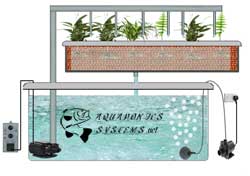 excess nutrient solution (that rest at bottom of the grow bed):
excess nutrient solution (that rest at bottom of the grow bed):
Collected and dripping back into the tank of the nutrient solution to be reused.
The use of nutrient solution:
Reuses the nutrient solution, so it is an economical hydroponic system.
The timer:
Inexpensive timer can be used (cause it needs less control in the watering cycles)
Maintenance:
More maintenance (The excess nutrient solution is collected back to the tank to be reused. This leads to change in the nutrient strength and pH of the tank, so periodic checking and adjusting is in need in this system)
Non-Recovery system
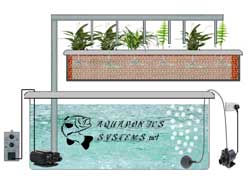 excess nutrient solution (that rest at bottom of the grow bed):
excess nutrient solution (that rest at bottom of the grow bed):
Not going to be reused.
The use of nutrient solution:
Uses more nutrient solution.
The timer:
Needs expensive timer (To secure enough control on the watering cycle, to insure that the plants get enough nutrient solution and the runoff is kept to a minimum)
Maintenance:
Less maintenance (The excess nutrient solution is not collected back into the tank, so the nutrient strength and pH of the tank will not change)
N.F.T. (Nutrient Film Technique)
When we hear Hydroponic systems first image comes to everyone’s mind is the N.F.T system.
N.F.T. System Stages
- We put the nutrient solution into the tank
- Air pump is bubbling air into the tank to supply with oxygen the nutrient solution
- Nutrient pump is pushing the nutrient solution from the tank into the grow-bed (Usually a tube) in constant flow way
- Small plastic baskets are used to hold the plants while the roots are falling into the nutrient solution
- The roots absorb all the water, nutrient, and oxygen, which the plants need to grow
- The excess nutrient solution return back into the tank by the end of the tube
N.F.T. System Negatives
Problem of the N.F.T. system is the cases of power outages, which will lead to dry roots because of the shortage of the nutrient solution.
N.F.T. System - Why to Use?
N.F.T. is money saving hydroponic system because it is not using any growing media but air.
AEROPONIC
Another no growing media system, it is the most high-tech form of all the Hydroponic systems, so we developed a new area in our Aquaponics Systems Site especially for it. Click here to find out all about aeroponic systems.

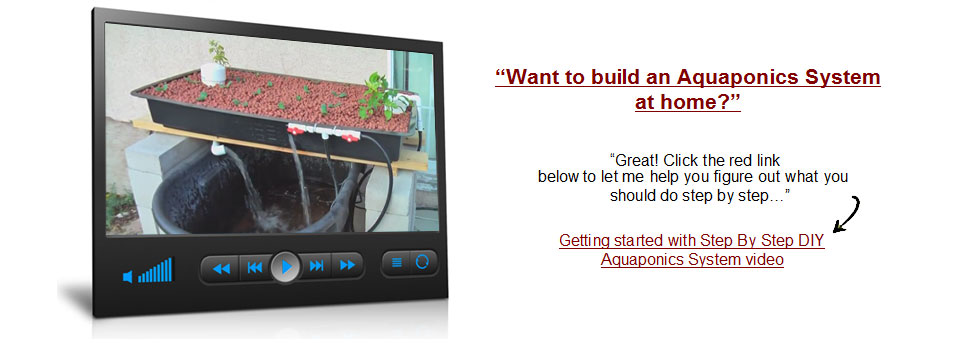




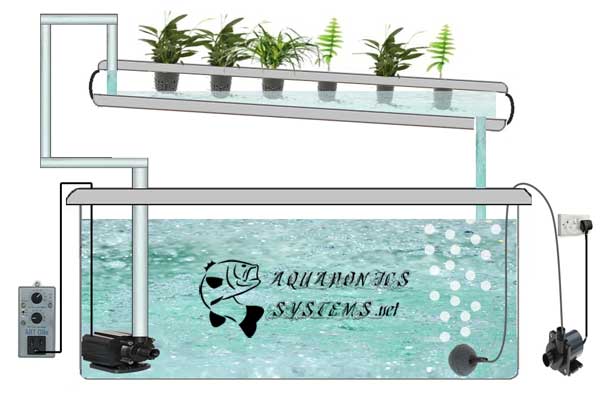
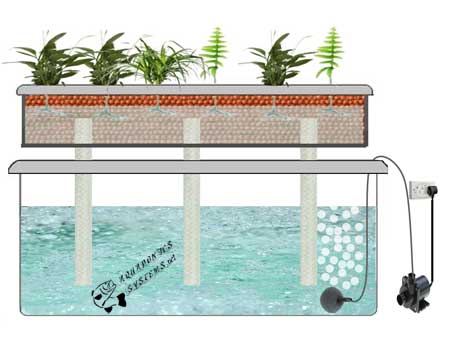
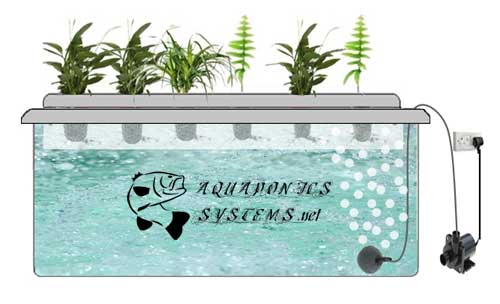
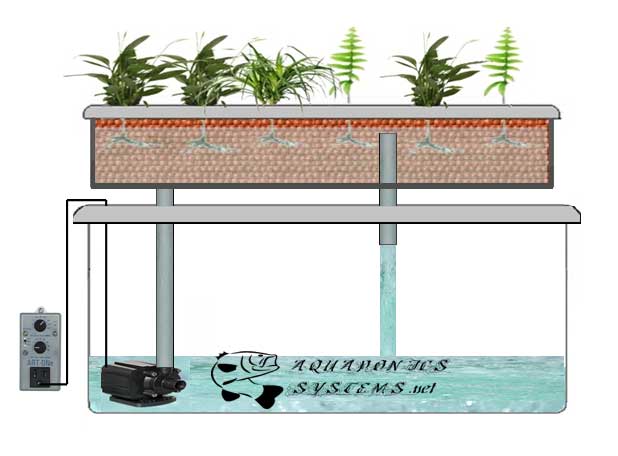

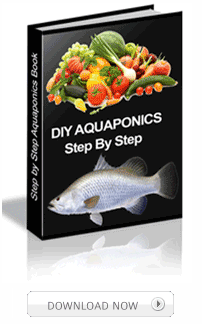
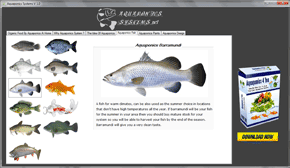






Comment
John Powell
October 22, 2014 at 4:23 pmHello,
Do you sell aquaponic systems .
Trackbacks for this post